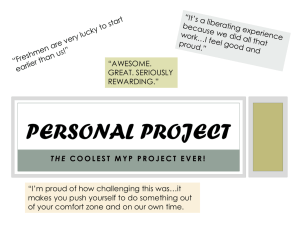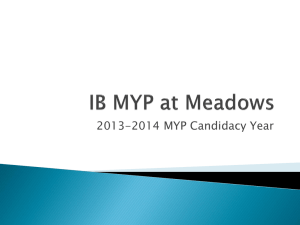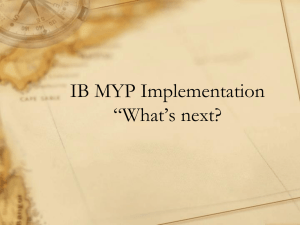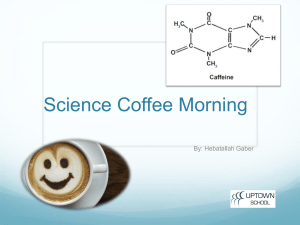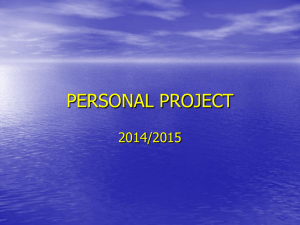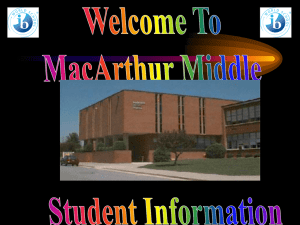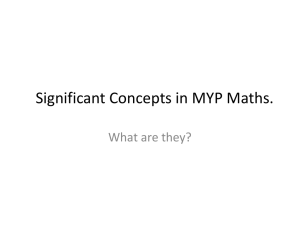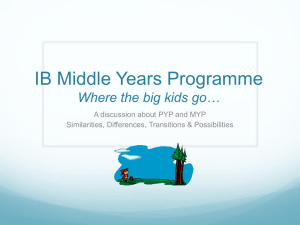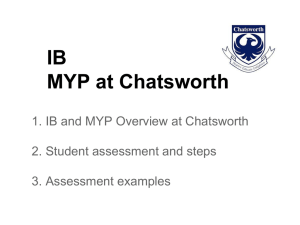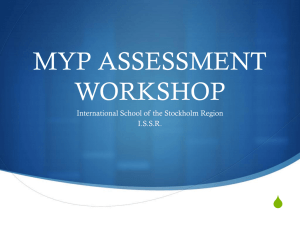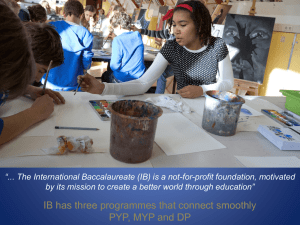Significance of the MYP Programme
advertisement
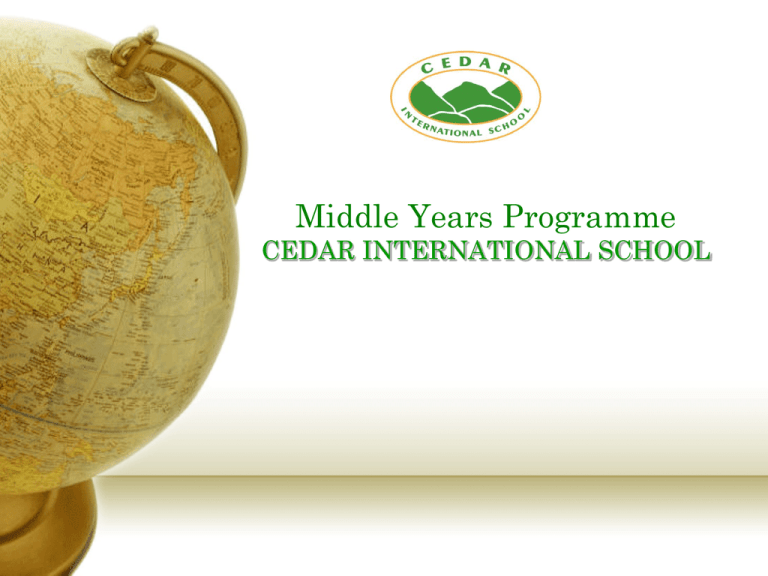
Middle Years Programme CEDAR INTERNATIONAL SCHOOL Philosophy: Programme model Page 2 What is the learner profile? IB learners strive to be: Inquirers Knowledgeable Thinkers Communicators Principled Open-minded Caring Risk-takers IB programmes promote the education of the whole person, emphasizing intellectual, personal, emotional and social growth through all domains of knowledge. Balanced Reflective Significance of the MYP Programme • Significant to the IB and MYP learner profile is the idea of ‘Student Centered Learning’ • “Letting Go” • When students become ‘owners’, they take ‘ownership’ and when they do this…they ‘buyin’…we can then act as a facilitator to their learning! The aim of the MYP • Is to instill and encourage a philosophy of education that gives the opportunity for all students to achieve academic excellence with responsible citizenship • The MYP is NOT a set curriculum – it does not dictate WHAT we teach. • It does guide HOW we teach. As a result of MYP? • Students should become… • Independent Learners • Recognise links between school subjects and the wider world • Be able to adapt to new situations • Be able to combine knowledge, practical and social skills to solve real world problems, alone or in a group. What are the fundamental concepts of the MYP? • Holistic learning • Intercultural awareness • Communication How is the Middle Years Programme defined? The MYP is: • for students aged 11 to 16 • a framework of academic challenge • 8 subject groups, plus personal project in the final year • taught in any language The MYP encourages students to: • understand the connections between subjects through interdisciplinary learning • understand the connections between subjects and the real world • become critical and reflective thinkers Page 8 What are the areas of interaction? Approaches to learning Community and service Health and social education Environments Human ingenuity Page 9 AOI’s cont. • Different coloured “glasses” that are used to look through. • They help students to think from a different perspective Approaches to learning Through approaches to learning, teachers provide students with tools to: • Take responsibility for their own learning • Develop awareness of how they learn best • Develop problem solving and decision making skills • Develop awareness of thought processes and learning strategies • Develop critical, coherent and independent thought Page 11 How do I learn best? How do I communicate my understanding? Community & service This area of interaction extends learning beyond the classroom and requires students to: • Develop community awareness and concern • Develop a sense of responsibility • Take an active part in the communities in which they live, thereby encouraging responsible citizenship • Develop skills and attitudes that will enable effective contributions to society Page 12 How do we live in relation to each other? How can I contribute to the community? How can I help others? Health & social education Deals with a variety of human issues including physical, social and emotional health and intelligence. Students will: • be aware of the relationship between the individual and society • take responsibility for their own well-being and for that of others • take responsibility for their social environment • be able to make informed choices for themselves with consideration for the wider society Page 13 How do I think and act? How am I changing? How can I look after myself and others? Environments Aims to develop awareness of humanity’s interdependence with a range of environments so that students: Understand issues within natural, built and virtual environments Take responsibility for maintaining and improving environments that are fit for the future Take action on issues explored through this area of interaction Page 14 What are our environments? What resources do we have or need? What are my responsibilities? Human ingenuity Students explore the ways that human minds have influenced our lives. Students will: Page 15 • become aware of the nature of ingenuity • reflect on the impact of innovations and creations, ideologies and ways of thinking, • appreciate the consequences of actions Why and how do we create? What are the consequences? Assessment: How do we assess student learning in the MYP? • Involves a range of task types • Assessment of knowledge, concepts, skills and attitudes • Criterion referenced • Each Subject has a different set of criterion • Internally assessed (by teachers) • Externally moderated for global standardization Page 16 Types of assessment Formative Summative During the teaching and learning process Generally at the end of a teaching and learning period/process Provides feedback Provides a judgment Helps students reflect on learning Gives opportunities for students to show what they have learned Help teachers plan their teaching MYP Units of Work • In the MYP, teaching and learning are planned through MYP Units of Work (‘Unit Plans’). • Backwards Design… • Driven by a guiding question • Involve students in a range of learning experiences • Subject based or interdisciplinary • Key Elements: • • • • • • Significant Concepts AOI Focus Assessment techniques Reflection MYP objectives and criterion used Resources available and used MYP Personal Project Students in grade 10 must complete a personal project. This will show understanding of the Areas of Interaction, ability to self direct themselves and work to deadlines to complete a substantial piece of work. This can take various forms, for example: • • • • an essay a piece of creative writing an original science experiment the organization of an event. The work must : • • • be completely independent focus on at least one area of interaction in addition to approaches to learning focus on the process of completing the project as well as the finished product. Overview International Baccalaureate Middle Years Programme • • • • • • • • Page 20 A programme for 11-16 year olds Student-centered programme Range of academic disciplines Academically rigorous Areas of interaction connect disciplines to the real world Can be taught in any language Flexible enough to be used with local requirements Designed and reviewed by experienced, practicing educators
